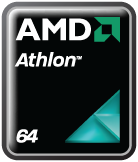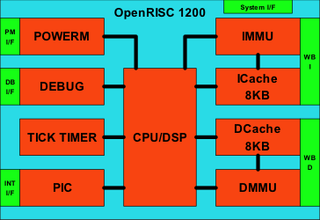
A microcontroller is a small computer on a single metal-oxide-semiconductor (MOS) integrated circuit (IC) chip. In modern terminology, it is similar to, but less sophisticated than, a system on a chip (SoC); a SoC may include a microcontroller as one of its components. A microcontroller contains one or more CPUs along with memory and programmable input/output peripherals. Program memory in the form of ferroelectric RAM, NOR flash or OTP ROM is also often included on chip, as well as a small amount of RAM. Microcontrollers are designed for embedded applications, in contrast to the microprocessors used in personal computers or other general purpose applications consisting of various discrete chips.

An embedded system is a computer system—a combination of a computer processor, computer memory, and input/output peripheral devices—that has a dedicated function within a larger mechanical or electrical system. It is embedded as part of a complete device often including electrical or electronic hardware and mechanical parts. Because an embedded system typically controls physical operations of the machine that it is embedded within, it often has real-time computing constraints. Embedded systems control many devices in common use today. Ninety-eight percent of all microprocessors manufactured are used in embedded systems.

A system on a chip is an integrated circuit that integrates all or most components of a computer or other electronic system. These components almost always include a central processing unit (CPU), memory, input/output ports and secondary storage – all on a single substrate or microchip, the size of a coin. It may contain digital, analog, mixed-signal, and often radio frequency signal processing functions.

In computing, overclocking is the practice of increasing the clock rate of a computer to exceed that certified by the manufacturer. Commonly, operating voltage is also increased to maintain a component's operational stability at accelerated speeds. Semiconductor devices operated at higher frequencies and voltages increase power consumption and heat. An overclocked device may be unreliable or fail completely if the additional heat load is not removed or power delivery components cannot meet increased power demands. Many device warranties state that overclocking and/or over-specification voids any warranty, however there are an increasing number of manufacturers that will allow overclocking as long as performed (relatively) safely.

A front-side bus (FSB) is a computer communication interface (bus) that was often used in Intel-chip-based computers during the 1990s and 2000s. The EV6 bus served the same function for competing AMD CPUs. Both typically carry data between the central processing unit (CPU) and a memory controller hub, known as the northbridge.

The Athlon 64 is an eighth-generation, AMD64-architecture microprocessor produced by AMD, released on September 23, 2003. It is the third processor to bear the name Athlon, and the immediate successor to the Athlon XP. The second processor to implement the AMD64 architecture and the first 64-bit processor targeted at the average consumer, it was AMD's primary consumer microprocessor, and primarily competed with Intel's Pentium 4, especially the "Prescott" and "Cedar Mill" core revisions. It is AMD's first K8, eighth-generation processor core for desktop and mobile computers. Despite being natively 64-bit, the AMD64 architecture is backward-compatible with 32-bit x86 instructions. Athlon 64s have been produced for Socket 754, Socket 939, Socket 940 and Socket AM2. The line was succeeded by the dual-core Athlon 64 X2 and Athlon X2 lines.
Central processing unit power dissipation or CPU power dissipation is the process in which central processing units (CPUs) consume electrical energy, and dissipate this energy in the form of heat due to the resistance in the electronic circuits.
Underclocking, also known as downclocking, is modifying a computer or electronic circuit's timing settings to run at a lower clock rate than is specified. Underclocking is used to reduce a computer's power consumption, increase battery life, reduce heat emission, and it may also increase the system's stability and compatibility. Underclocking may be implemented by the factory, but many computers and components may be underclocked by the end user.

Intel's i960 was a RISC-based microprocessor design that became popular during the early 1990s as an embedded microcontroller. It became a best-selling CPU in that segment, along with the competing AMD 29000. In spite of its success, Intel stopped marketing the i960 in the late 1990s, as a result of a settlement with DEC whereby Intel received the rights to produce the StrongARM CPU. The processor continues to be used for a few military applications.

The Aerojet Rocketdyne RS-25, also known as the Space Shuttle main engine (SSME), is a liquid-fuel cryogenic rocket engine that was used on NASA's Space Shuttle. NASA is planning to continue using the RS-25 on the Space Shuttle's successor, the Space Launch System (SLS).
The thermal design power (TDP), sometimes called thermal design point, is the maximum amount of heat generated by a computer chip or component that the cooling system in a computer is designed to dissipate under any workload.

Geode was a series of x86-compatible system-on-a-chip microprocessors and I/O companions produced by AMD, targeted at the embedded computing market.
Bandwidth throttling is the intentional slowing or speeding of an internet service by an Internet service provider (ISP). It is a reactive measure employed in communication networks to regulate network traffic and minimize bandwidth congestion. Bandwidth throttling can occur at different locations on the network. On a local area network (LAN), a system administrator ("sysadmin") may employ bandwidth throttling to help limit network congestion and server crashes. On a broader level, the Internet service provider may use bandwidth throttling to help reduce a user's usage of bandwidth that is supplied to the local network. Bandwidth throttling is also used as a measurement of data rate on Internet speed test websites.
Manifold vacuum, or engine vacuum in an internal combustion engine is the difference in air pressure between the engine's intake manifold and Earth's atmosphere.
A transmission control unit (TCU) is a device that controls modern electronic automatic transmissions, and can also be coupled with semi-automatic paddle-shift transmissions in racecars. A TCU generally uses sensors from the vehicle as well as data provided by the engine control unit (ECU) to calculate how and when to change gears in the vehicle for optimum performance, fuel economy and shift quality.
The memory controller is a digital circuit that manages the flow of data going to and from the computer's main memory. A memory controller can be a separate chip or integrated into another chip, such as being placed on the same die or as an integral part of a microprocessor; in the latter case, it is usually called an integrated memory controller (IMC). A memory controller is sometimes also called a memory chip controller (MCC) or a memory controller unit (MCU).
Dynamic frequency scaling is a technique in computer architecture whereby the frequency of a microprocessor can be automatically adjusted "on the fly" depending on the actual needs, to conserve power and reduce the amount of heat generated by the chip. Dynamic frequency scaling helps preserve battery on mobile devices and decrease cooling cost and noise on quiet computing settings, or can be useful as a security measure for overheated systems. Dynamic frequency scaling is used in all ranges of computing systems, ranging from mobile systems to data centers to reduce the power at the times of low workload.
Low-power electronics are electronics, such as notebook processors, that have been designed to use less electric power than usual, often at some expense. In the case of notebook processors, this expense is processing power; notebook processors tend to consume less power than their desktop counterparts, at the expense of lower processing power.

The OpenRISC 1200 (OR1200) is an implementation of the open source OpenRISC 1000 RISC architecture.
The KOMDIV-64 is a family of 64-bit microprocessors developed by the Scientific Research Institute of System Development (NIISI) of the Russian Academy of Sciences and manufactured by TSMC, UMC, GlobalFoundries, and X-Fab. The KOMDIV-64 processors are intended primarily for industrial and high-performance computing applications.









